News
Article
Study Highlights Efficacy of Dupilumab for Atopic Dermatitis in Head, Neck Regions
Author(s):
These findings confirm the ways in which patient responses in the head and neck areas contribute to modifications in life quality among those with eczema.

Treatment of atopic dermatitis with dupilumab is partially effective within patients’ head and neck regions, recent findings confirmed, though a significant portion (45%) of individuals with the skin disease may see benefits in these regions.1
These conclusions resulted from new research led by Gabriele Perego, from the department of pathophysiology and transplantation at the University of Milan in Italy. Perego et al. noted in this research letter that the presence of eczema on the head and neck areas is linked to lower quality of life levels given these regions’ visibility and the disease’s impact on relationships.
“Phase III clinical trials have demonstrated its efficacy in clinically improving various anatomical regions, supporting a nearly overlapping reduction in the Eczema Area and Severity Index (EASI) in areas such as the head–neck, upper extremities, lower extremities, and trunk,” Perego and colleagues wrote. “Real-life data published in the literature, however, are scant and suggest a different response to the drug in the affected body sites, especially in the head–neck area.”2,3
Study Design
As highlighted previously, the investigators noted that prior research into the monoclonal antibody—which targets IL-4 and IL-13 signaling pathways—had suggested it was effective in symptom improvement for patients with atopic dermatitis in different bodily regions.
These improvements, for example, led to reduction in patients’ Eczema Area and Severity Index (EASI) scores in such areas of the body as the upper and lower extremities, head-neck, and trunk.
AD in the head and neck region is associated with a lower quality of life (QoL) due to the visibility of these areas and their impact on daily activities and relationships. Our study shows that nonresponders consistently have higher DLQI and ADCT scores, highlighting how treatment response in the head and neck region significantly affects overall QoL for patients with AD.
In their current study, Perego and colleagues expressed that 553 patients that had severe atopic dermatitis in their head-neck region were included. All of these individuals were treated with dupilumab and evaluated for their results.
The specific clinical evaluations utilized by the research team included scores on the Atopic Dermatitis Control Tool (ADCT), Pruritus Numerical Rating Scale (NRS), EASI, and Dermatology Life Quality Index (DLQI), as well as the general extent of head and neck involvement. By the point of initiation of treatment, as well as every 4 months thereafter, data were gathered by the team.
For the investigators to note distinctions among trial participants’ ADCT and DLQI scores among clinical groups, they implemented T-tests or Mann–Whitney U-tests. Each of their analyses were 2-tailed, with the significance level being set by the investigators at P < 0.05.
Findings
Total disease remission was reported by the research team to have occurred among 30.7% of subjects that had involvement of the head and neck regions, taking place within the initial 4 treatment months. The team also found that 45.1% had achieved complete remission within the initial year of therapy and 55% after 3 years.
The investigators noted that following the 36-month mark, the percentage of individuals who reported involvement on the face had diminished to 42.6%. They also found that 21.8% of these subjects had persistent disease involvement and that 78.2% had been shown to have intermittent patterns.
Far greater scores on the DLQI and ADCT were observed among those labeled as nonresponders versus those who were responders in all of the available comparisons. Overall, the research team concluded that among individuals who did not achieve a total remission of disease, the proportion of those with persistent involvement diminished over the course of time, favoring an intermittent pattern.
The team highlighted the difficulty in treating the head-neck area in a variety of skin conditions, given such elements as exposure to UV rays, aeroallergens, and use of cosmetic products. The extension of eczema treatment past a single year was noted by the investigators as potentially helping some initially non-responding individuals by resulting in total remission or transitioning the disease from a persistent to an intermittent form.
The team’s conclusions were also noted as raising newer questions regarding optimal timing for discontinuation of dupilumab in favor of other types of therapies. The investigators expressed that this research had been the largest to date looking at patients with disease in this area, with findings confirming that while the drug is somewhat efficacious in patients’ head and neck regions, there are a major portion of individuals who would benefit from such a therapy.
“Our study, which demonstrates that DLQI and ADCT consistently remain higher in nonresponder patients, confirms how the response in the head and neck region contributes to the overall modifications of QoL in patients affected by (atopic dermatitis),” they wrote.
References
- Perego G, Aromolo IF, Ferrucci S, et al (2024). Effectiveness of dupilumab in atopic dermatitis on the head and neck: a single-center study on 553 patients. Int J Dermatol. https://doi.org/10.1111/ijd.17278.
- Blauvelt A, Rosmarin D, Bieber T, Simpson EL, Bagel J, Worm M, et al. Improvement of atopic dermatitis with dupilumab occurs equally well across different anatomical regions: data from phase III clinical trials. Br J Dermatol. 2019; 181(1): 196–197.
- Vittrup I, Krogh NS, Larsen HHP, Elberling J, Skov L, Ibler KS, et al. A nationwide 104 weeks real-world study of dupilumab in adults with atopic dermatitis: ineffectiveness in head-and-neck dermatitis. J Eur Acad Dermatol Venereol. 2023; 37(5): 1046–1055.





